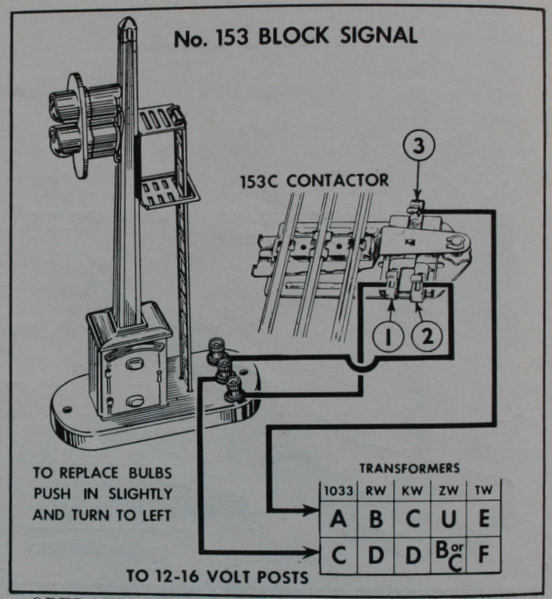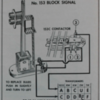First, lets us look get some electrical basics down. A light bulb has two terminals, one for hot, one for return/common/ground.
Now, lets look at your signal. It has two light bulbs, so one may expect 4 terminals, two for each bulb. However, in this case, one wire can be shared with both light bulbs, giving us three terminals. The center terminal is shared between the bulbs, and then the outer terminals connect each to one bulb.
For testing purposes, you can take ~14VAC from your power source and connect cone wire to the center post, and then touch the other wire to an outside post. By touching an outside post, you should get one light to illuminate. Touching the other outside post should cause the other light to illuminate.
Now we have the basics down and we can get a little more advanced.
153C Contactor
Included is a 153C contactor. Terminal 3 on the 153C now gets connected to the wire you used to touch the outside terminal for testing. Terminals 1 ans 2 go to the outside terminal of the signal. Terminal 1 is Normally Closed and generally should be connected to the green bulb. Terminal 2 is Normally Open, when weight presses down on the 153C, it becomes closed (and terminal 1 becomes open) changing illuminated light to the red one.
The thumb adjustment screw changes the weight sensitivity of the 153C contactor.

Relays
Now, it can be hard to tune the 153C to get the desired operation, so relays of all kinds have been used. Instead of weight triggering the change between lights, a solenoid is used. So you still have 3 terminals as before, a "switched common", "normally open", and "normally closed". But now you add two terminals for the solenoid, "activation hot" and "activation return/common/ground".
Now to trigger the solenoid...
Relay & Insulated Track
Take the activation hot of your relay and connect it to your center rail or accessory buss (with common ground wiring scheme). Take the activation return/common/ground and connect it to the insulated activation rail. The metal wheels and axles will conduct complete the circuit between the outside rail and the outside insulated activation rail, trigger the relay to switch on its solenoid and change the illumination state of the signal.
Now, there are many products that have the relay functionality built in that I can recommend, but possibilities are endless. It sounds like you may also have a relay you can already use:
O22
Now, if you have an O22 switch, you can directly hook the signal's three terminals directly up to the three terminals on the O22 switch (along with the O22C controller) and control the light state based on switch direction. The O22 is essentially acting as a latching relay.
I hope that this all points you in a direction and get you on your way. It is quite a bit to take in, especially if one is not electrically inclined, so don't hesitate to ask clarifying questions.
Edit: There was no activity on this topic when I started compiling my response, and then once I completed and proof read it for submission, I guess a lot happened!











